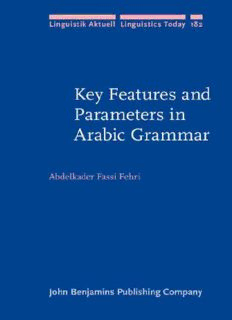Table Of ContentKey Features and Parameters in Arabic Grammar
Linguistik Aktuell/Linguistics Today (LA)
Linguistik Aktuell/Linguistics Today (LA) provides a platform for original monograph
studies into synchronic and diachronic linguistics. Studies in LA confront empirical
and theoretical problems as these are currently discussed in syntax, semantics,
morphology, phonology, and systematic pragmatics with the aim to establish robust
empirical generalizations within a universalistic perspective.
For an overview of all books published in this series, please see
http://benjamins.com/catalog/la
General Editors
Werner Abraham Elly van Gelderen
University of Vienna / Arizona State University
University of Munich
Advisory Editorial Board
Josef Bayer Christer Platzack
University of Konstanz University of Lund
Cedric Boeckx Ian Roberts
ICREA/Universitat Autònoma de Barcelona Cambridge University
Guglielmo Cinque Lisa deMena Travis
University of Venice McGill University
Liliane Haegeman Sten Vikner
University of Ghent University of Aarhus
Hubert Haider C. Jan-Wouter Zwart
University of Salzburg University of Groningen
Terje Lohndal
University of Maryland
Volume 182
Key Features and Parameters in Arabic Grammar
by Abdelkader Fassi Fehri
Key Features and Parameters
in Arabic Grammar
Abdelkader Fassi Fehri
KAICAL, Ryad & Mohammed V University, Rabat
John Benjamins Publishing Company
Amsterdam / Philadelphia
TM The paper used in this publication meets the minimum requirements of
8
the American National Standard for Information Sciences – Permanence
of Paper for Printed Library Materials, ansi z39.48-1984.
Library of Congress Cataloging-in-Publication Data
Fassi Fehri, Abdelkader.
Key features and parameters in Arabic grammar / Abdelkader Fassi Fehri.
p. cm. (Linguistik Aktuell/Linguistics Today, issn 0166-0829 ; v. 182)
Includes bibliographical references and index.
1. Arabic language--Grammar. I. Title.
PJ6106.F348 2012
492.7’5--dc23 2011048226
isbn 978 90 272 5565 5 (Hb ; alk. paper)
isbn 978 90 272 7496 0 (Eb)
© 2012 – John Benjamins B.V.
No part of this book may be reproduced in any form, by print, photoprint, microfilm, or any
other means, without written permission from the publisher.
John Benjamins Publishing Co. · P.O. Box 36224 · 1020 me Amsterdam · The Netherlands
John Benjamins North America · P.O. Box 27519 · Philadelphia pa 19118-0519 · usa
For Heroes of Arab Revolutions
Table of contents
Foreword xv
Provenance of chapters xix
part i. Temporality, aspect, voice, and event structure 1
chapter 1
Tense/Aspect interaction and variation 3
1. Past, Perfect, Perfective 5
1.1 The Past/Perfect ambiguity 5
1.2 Temporal and modal qad 7
1.3 One or two projections of T 9
1.4 Perfective 9
2. Present, Imperfect, Imperfective 10
3. Imperfect and SOT 13
4. Perfectivity 16
4.1 ST as Perfective 16
4.2 PT as Imperfective? 20
4.3 From Tense to Aspect 22
4.4 The Tense/Aspect language typology revisited 24
5. Conclusion 25
chapter 2
Transitivity, causativity, and verbal plurality 27
1. Issues 28
1.1 Problem 1: Semitic morpho-syntax 28
1.2 Problem 2: Transitivity theory 29
2. Number Theory 31
2.1 Ingredients of Num theory 31
2.2 Verbal plurality and distributed Num 32
2.3 Distributed plurality 33
2.4 Causative complexity, verbalization, and distributivity 33
2.5 Two sources of transitivity 35
2.6 Parallel plural morphology 36
2.7 Summary 40
3. Cross-linguistic evidence 41
viii Key Features and Parameters in Arabic Grammar
3.1 Causatives, transitives, and event quantification 41
3.1.1 Causativization and transitivization 42
3.1.2 Multiple behaviour 43
3.1.3 Event quantification 44
3.2 Moravcsik’s resistant cases 45
4. Conceptual motivations and competing analyses 46
4.1 Little v: Verbalizer or transitivizer? 46
4.2 Aspect 47
4.3 Voice 50
4.3.1 Anti-transitive reflexives 51
4.3.2 Reflexive causatives 52
4.3.3 Agentive and “expositive” causatives 53
4.3.4 “Requestive” causatives 53
4.3.5 Ergative Num and intensive forms 54
4.4 Further empirical motivations 55
4.4.1 Ergative and unergative Num in event plurality and
transitivity 55
4.4.2 Adicity, (in)transitive alternations, and multiple uses 55
5. Num theory and Num heights 57
5.1 Sg and Pl Merge 57
5.2 Language variation 57
6. Summary and conclusion 58
chapter 3
Synthetic/analytic asymmetries in voice and temporal patterns 61
1. Analysis, voice, and temporality 65
1.1 The problem 65
1.2 Nominal auxiliaries 66
1.3 S/O Agr split and auxiliary selection 67
1.4 Temp auxiliaries 69
1.5 Voice 71
1.5.1 Arabic and anaphoric Agr 71
1.5.2 Latin and split Agr 72
1.5.3 Modern Greek 74
1.5.4 Albanian 75
1.5.5 Moroccan Arabic 76
2. Formal complexity and categorization 79
2.1 Further analytic and synthetic questions 80
2.1.1 Pass and additional complexity 80
Table of contents ix
2.1.2 Two finite Agrs 80
2.1.3 Ancient Greek as fully synthetic 81
2.2 Reanalysis as the source of analytic pass or perfect 82
2.3 A splitting analysis (of Temp and Agr categories) 83
3. Peculiarities and structural heights 85
3.1 Imperfective passive 85
3.2 Verbal and adjectival voices 86
3.3 Multiple functions across heights 89
4. S ummary and conclusion 91
chapter 4
Arabic Perfect and temporal adverbs 93
1. Salient properties of the Arabic TR system 94
1.1 Polyfunctionality of T/Asp forms 94
1.2 The PresPerf split: Synthesis and analysis 95
1.3 The Past split: Simple Past Pfv and complex Past Impfv 96
2. The Perfect/Past ambiguity 99
2.1 Aspects and Tenses 100
2.2 Positional “deictic” adverbs 103
2.3 Perf and modal qad 104
2.4 Adverbs and simple vs. complex tenses 106
2.5 Durational adverbs 107
3. Temporal adverbs and kinds of Perfect 110
3.1 Positional munđu 110
3.1.1 Imperfective tenses 110
3.1.2 Perfective tenses 111
3.1.3 PresPerf tense 112
3.2 Durational munđu 113
3.3 Perf of Res and Post-state 113
4. Summary and conclusion 115
4.1 T/Asp morphology 115
4.2 T/Asp adverbs or particles 116
4.3 Conclusion 116
part ii. DP, np, bareness, and count/mass structures
chapter 5
The grammar of count and mass 121
1. Toward a wider count grammar 122
1.1 Ways of ‘numeralizing’ 124
Description:In light of recent generative minimalism, and comparative parametric theory of language variation, the book investigates key features and parameters of Arabic grammar. Part I addresses morpho-syntactic and semantic interfaces in temporality, aspectuality, and actionality, including the Past/Perfect/

